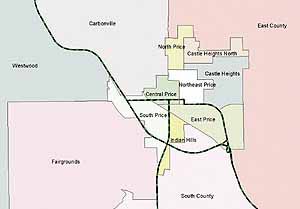| Click image to enlarge |
The United States Census results compiled nearly two years ago are coming to roost in Carbon County and some residents are not happy with the situation.
The census process was, as usual, controversial. When the first count was taken in the late 18th century, some census takers were lynched or shot for prying into Americans’ lives. People felt it was an intrusion into their privacy. In the type of society that existed then, the gun was often the law.
The complaints lodged by U.S. citizens today is no different. Many 2000 census takers had the door of homes slammed in their faces by people not wanting to give out information.
Other census workers found that citizens gave out some information easily, while other questions were met with resistance, particularly inquiries on the long form.
The census was originally organized by the U.S. Congress to determine how many people lived in any certain area so voting districts could be set up according to population.
States with more people would get more seats in the U.S. House of Representative. To provide balance, every state got two senators no matter how large populations were.
The original intent of the census has been changed to include more questions about how many people live in a household, income information and demographic data.
The answers often affect everything from how much federal money a state may get for road construction to special programs for school kids.
The basis for the census is still the voting districts and that is what probably affected Carbon County more than anything in the last go around in 2000.
Due to the changes in population based on census figures, the Utah Legislature had to make changes in representatives seats, both at the national and the state levels.
The changes Utah lawmakers approved may not only impact who represents Carbon County residents at the national level in the U.S. House, but also who represents them in the state side of government.
On the national scene, Jim Matheson currently represents Carbon County in the U.S. Congress. That is because the Utah Legislature has flip flopped the areas that he and Chris Cannon represent in order to adjust the voter numbers within the districts.
At the state level, Sen. Mike Dmitrich has kept much of the area in eastern and southeastern Utah in his district’s boundaries, including all of Carbon County. However, Dmitrich lost some areas in southwestern Utah.
On the other hand, Brad King’s Utah House of Representatives area has been split, with everything west of the Price city limits going to district 67.
Some school board boundaries also changed based on the 2000 population counts.
In addition, counties are required to change voting precincts when one local district approaches 1,000 people. The requirement also means, that when the number of citizens in a precinct drops too low, the district may well be combined with another area to make it a more optimal size.
Some of the things recently happened in Carbon County, when the clerk’s office had to set up new precincts by Jan. 30 to meet the deadline set by the Utah Legislature.
“We have gone from 19 to 23 precincts,” pointed out Carbon Clerk-Auditor Robert Pero. “We had 20 precincts and had to eliminate one and add four more.”
With the approach of the June primaries and the November general election, the changes will affect voters throughout the county.
“First of all, we eliminated Kenilworth as a precinct,” explained Pero during an interview with the Sun Advocate. “It has been combined with Spring Glen.”
The county clerk’s office split some districts where the populations were rising to above acceptable levels.
East Carbon City, for instance, has been split into two separate precincts. The dividing point is the wash that runs through town, putting part of East Carbon City with Columbia.
“It may sound funny to use a wash as the dividing point for a voting precinct,” said Pero, whose office has the responsibility for resetting the county’s new voting precinct boundaries. “But it’s a good division point.”
Actually, using landmarks as dividing lines is not unprecedented. In formatting new state representative districts, the Utah Legislature not only utilized landmarks like roads and washes, but used a power line in one case.
Wellington has also been split down the middle by using U.S. Highway 6 as the dividing point.
“We also created another district in south Price called Indian Hills,” pointed out Pero.
All of the precinct changes will affect the poll habits of numerous Carbon County voters, according to officials. Many resigistered residents will have to go different places to vote than they have in the past.
“There are so many changes that we have decided to sent out new voter registration cards to every registered voter in the county,” said Pero. “That means when people receive their cards they should check their information. It is important.”
The political process for the upcoming 2002 elections will begin soon. Mass meetings will be conducted on March 25. At the meetings, the political party candidates for the June 25 primary election will be selected.
“One thing we have had a lot of calls on is the declaration of party,” indicated Pero. “People need to know that they must declare, if they are going to vote in the Republican primary, that they are a Republican. That is not true for the Democrats or any of the other parties.”
In 2002, the offices that are up for re-election include the congressional candidate from Utah’s 2nd District, the state representative positions, all county offices except for one commissioner position, three Carbon School Board slots as well as one position for the state education board.
In addition, retention of several judgeships will be on the ballot.
The general election will be conducted on Nov. 5.

